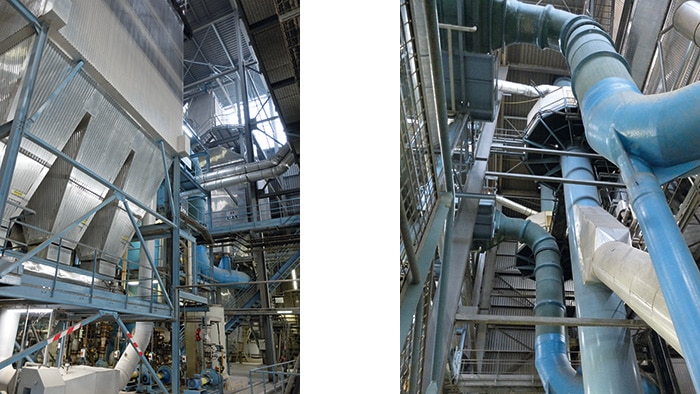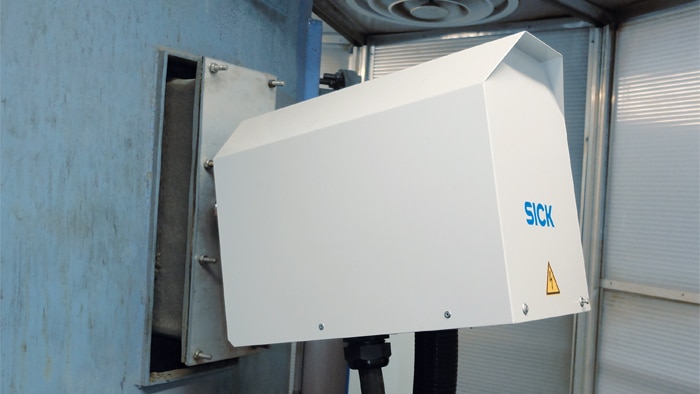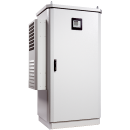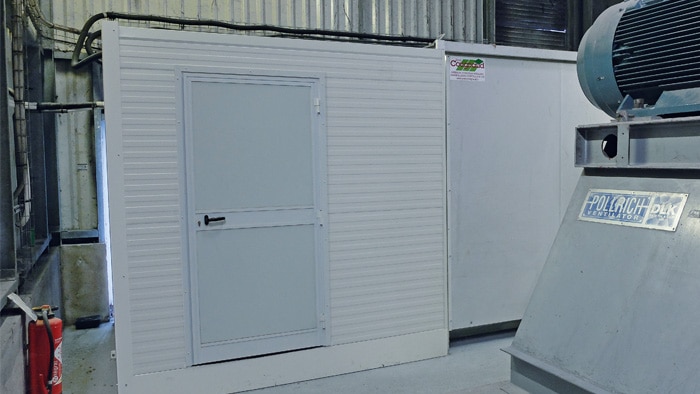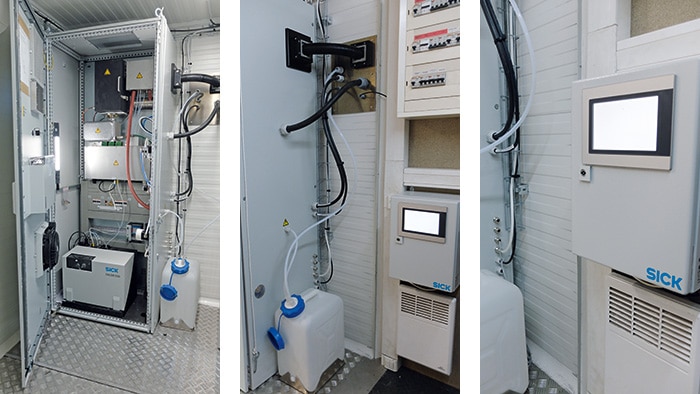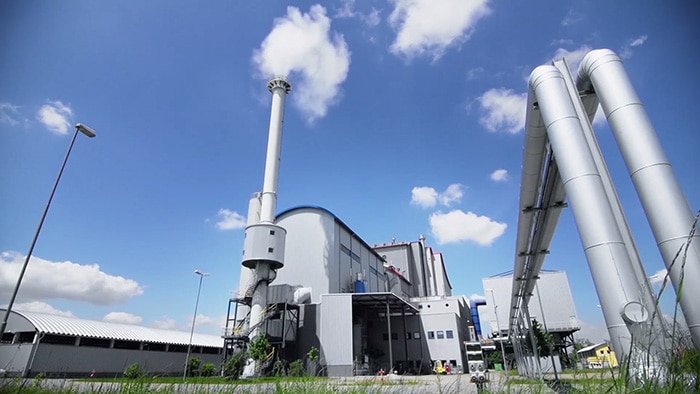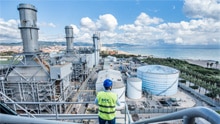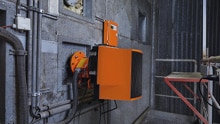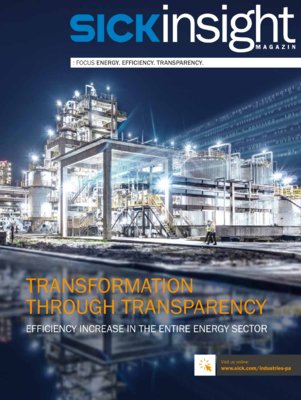Adherence to the regulations well before the statutory deadline: With the aim of reducing the environmental impacts globally, waste incineration plants need to adhere to ever lower limit values for emissions into the air. A new European reference document relating to waste incineration has recently been published. By late 2023 all incineration plants must adhere to new emission limit values and the mercury emissions in the exhaust gas must be continuously measured. The Syndicat Mixte de Valorisation des Déchets des Pays de Rance et de la Baie (SMPRB) and IDEX Environnement did not wait for this deadline, however, before implementing these requirements for their energy recovery plant located in Taden, France. A turnkey solution for mercury measurement from SICK has been in operation there since the beginning of 2022.
How a waste incineration plant meets the latest requirements on mercury emissions monitoring
Emission reduction and continuous monitoring: a challenge for operators of incineration plants
The energy recovery center for household waste in Taden has been operated by the company IDEX Environnement since 1998. Two furnaces, each with a capacity of 7 tonnes per hour, are continuously incinerating mostly household waste. Thanks to the heat produced, the center generates 45,000 MWh of electricity annually. To comply with the relevant statutory requirements, the flue gas treatment system was updated in 2005 and 2012.
The gases at the outlet of the boiler are directed to a dust extractor with filter hoses and then pass through a two-stage scrubber. The first, acidic stage is used to separate hydrochloric acid, hydrofluoric acid and heavy metals. In the second, basic stage sulfur dioxide is captured. After these steps, the exhaust gases pass through a catalytic converter in which nitrogen oxides, dioxins and furans are treated before being returned to the stack.
The new ordinance, which applies to existing plants from December 3, 2023, prescribes in particular new daily emission limits and the continuous measurement of mercury emissions into the air. These additional requirements present new challenges for this type of industrial plant. To achieve them, the performance of the flue gas cleaning system needs to be improved, or it needs to be replaced or modified. The plant may need to be equipped with new monitoring systems. At the same time, the aim is to keep the impact on the operating costs as low as possible.
The French regulations relating to incineration are very strict when it comes to the monitoring of air emissions. If no emission measurement is possible, the waste incineration must be stopped after just a few hours. These plants therefore need to be efficient and reliable and are strictly monitored.
Special case of continuous mercury measurement
Mercury is a heavy metal that is very poisonous to living things even at low concentrations. Although its use has been highly regulated and restricted in recent decades, minor quantities are still present in household waste. The mercury present in metallic form in the waste is converted into a gas after incineration in the furnace. A large part of this mercury is captured in the flue gas treatment system of the plant, however residual concentrations are emitted in the stack. These concentrations have to date been limited to 50 µg/Nm3, and a compulsory annual check by means of sample measurements is performed by an approved inspection body.
The new regulation now stipulates that the daily average emissions not exceed 20 µg/Nm3, and that the mercury concentration in the flue gas be continuously measured by an analyzer that is certified to European standards. This mercury measurement must not be out of operation for more than 500 h/year according to the new ordinance.
This poses a new challenge for operators for several reasons, for example:
- The limit values of just a few µg/m3 are very low. Other continuously monitored pollutants such as HCL, SO2, NOx are present at a 1000-fold higher concentration (mg/m3).
- The behavior of gaseous mercury in a waste incineration plant is complex. Mercury combines with other chemical compounds, i.e., it is adsorbed and desorbed by certain materials.
- The mercury content in the waste varies greatly, so mercury concentrations often occur in the form of peak values, with the concentrations only gradually falling again, however.
- To date only point measurements have been performed.
Selection of a fast, powerful and reliable measurement method for optimal operation of the plant
To ensure they are prepared before the statutory deadline arrives, the plant owner (SMPRB) and IDEX Environnement decided to immediately equip the two incineration lines with a continuous mercury measurement system at the stack. The measured values determined in the coming months will determine whether the current flue gas cleaning system meets the new emission requirements.
It was therefore crucial to select the right mercury analyzer to achieve this goal. Conformity with the European standards for continuous measurement systems is of course essential, however performance, reliability, ruggedness, and measurement availability were also important. SICK met all these criteria with its MERCEM300Z analyzer.
“After analyzing the various analyzers available on the market, the MERCEM300Z from SICK fully met the expectations that we had for our location. We were particularly impressed by this simple, tried-and-proven technology that offers low maintenance costs and a high availability. The fact that the system has already been performance tested by TÜV was also a decisive factor in our choice,” says Jurgen Poli, plant manager at IDEX Environnement.
SICK has been manufacturing the MERCEM300Z since 2011 and its reliability and ruggedness has been proven, in particular, in numerous installations at waste incineration plants and cement plants in Germany. Another big advantage is its outstanding patented technology with low maintenance requirements. The analysis unit is integrated into a climate-controlled or ventilated cabinet and all elements are easily accessible for maintenance. An integrated, certified automatic calibrator also reduces the frequency and duration of maintenance work.
Tailored to the requirements of the plant while also limiting costs
It is not always easy to install new equipment in an existing plant. The solution on offer needs to be future proof and at the same time must not interfere with the operation of the incineration plant.
“Our requirements specification called for a turnkey solution: mechanical and electrical installation, delivery of the analyzers, and commissioning. In particular we wanted to maintain our previous configuration by housing all analyzers at the site in a single room to ensure optimal operation. SICK extended the existing protective enclosure and installed the MERCEM300Z without interrupting the operation of the analyzers already present. We are very pleased with the result as our technicians now have more space for maintenance,” adds Poli.
Availability, cooperation with and management of the subcontractor: the secret for a successful project
After the proposed solution was approved, the project team at SICK took care of all of the work. Regular meetings with IDEX Environnement, SICK and its subcontractor for the installation/cabling part were arranged.
“We particularly appreciated the project management by SICK: We were regularly informed of the progress of the work, the schedule was adhered to, and the responses were clear and of a high quality. The works were prepared and carried out in good collaboration with the operations team and all safety requirements were met,” says Eric Girard, Deputy Director at IDEX Environnement and the person responsible for monitoring the work site.
Guaranteed reliable measurement solution
The analyzers for continuous mercury monitoring have been in operation since March 2022. Comparison measurements were performed by an approved body in order to confirm the proper installation and measurement quality of the analyzers as prescribed in the requirements. The report showed that the requirements were being fully met and the mercury concentration values determined using the reference method were very close to the measurements obtained with the MERCEM300Z, thereby confirming its outstanding precision.
This continuous measurement of liberated mercury must now comply with the statutory prescribed requirements on availability. SICK offers innovative service solutions to help satisfy these requirements:
- Constant remote monitoring of the analyzer status (condition monitoring), which makes it possible to preventively monitor the equipment and better respond to deviations.
- Secure remote maintenance so our experts can, if necessary, take corrective actions remotely.
- A guaranteed on-site intervention time by SICK experts, when required.
- Annual on-site preventive maintenance
Thanks to its service organization, national availability of its teams, and remote service offering, SICK is able to guarantee IDEX Environnement maximum availability and adherence to the statutory requirements.
Product and system support
Efficient service through
secure remote maintenance
Read more
Waste-to-energy plant in Spain installs SICK technology for emission measurement
Technology benchmarking: Indian power plants focus on environmental technology advancements
Condition monitoring in energy supply: Answers from the future
Waste-to-energy and transparent data: Early detection of untreated gas peaks

